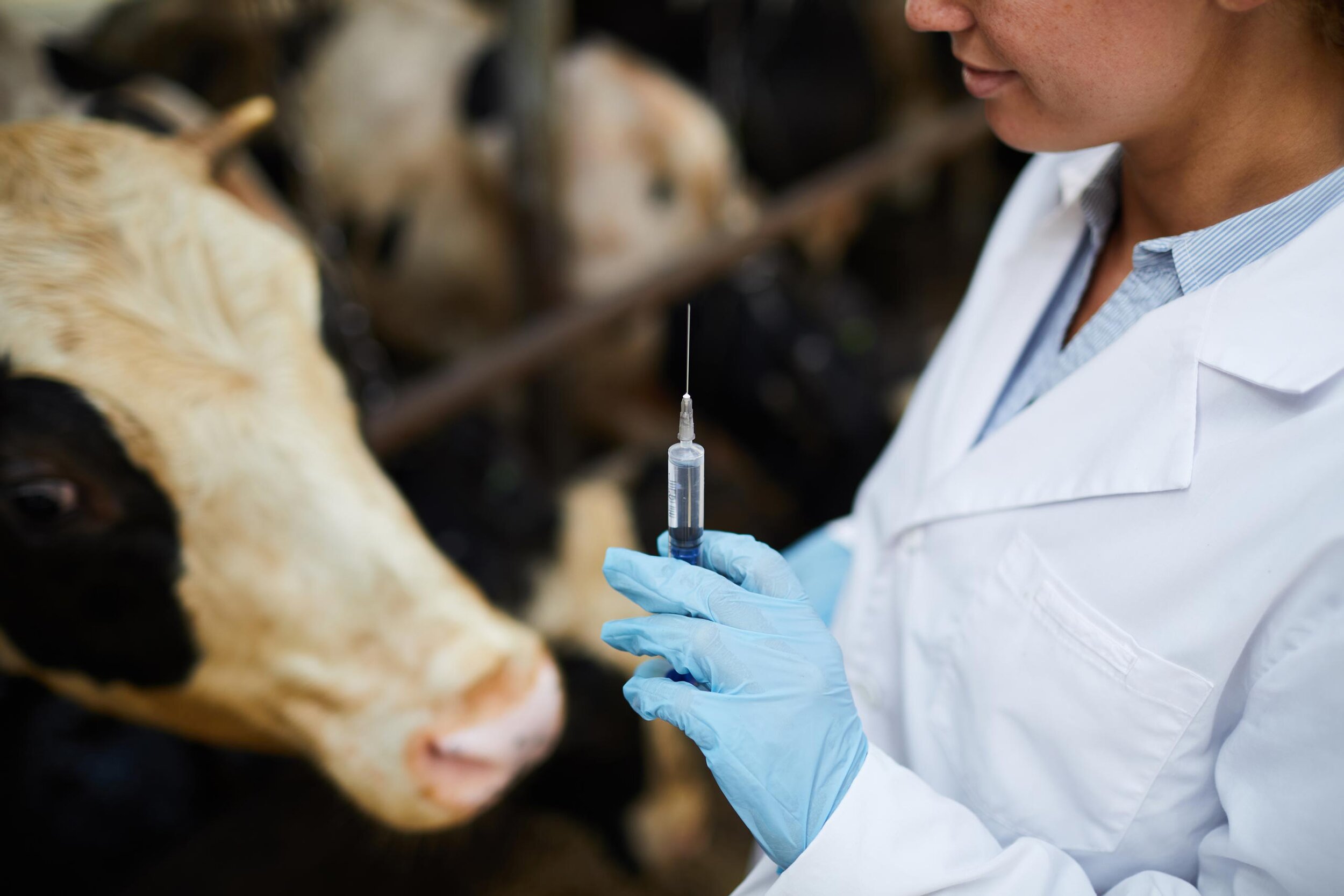
BVD Vaccines
When there are breaks in your biosecurity or you can’t prevent pregnant cattle from getting from getting infected, vaccinating for bovine viral diarrhoea (BVD) can help protect your herd against the many negative impacts of BVD.
How do BVD vaccines work?
The main purpose of vaccinating cattle against BVD is to protect the fetus from getting infected with the virus during the risk period for developing persistent infections. The commercial BVD vaccines in New Zealand are what are known as inactivated vaccines, which means that they contain BVD virus particles that have been killed to prevent them from causing active infections. Although the immune system is still able to recognise the killed virus in the vaccine, it does not produce as strong an immune response against it compared with live vaccines or natural infections. This is the reason why animals that have never been vaccinated before will require two initial doses before they are fully protected and then annual boosters to keep up their immunity.
It is important to remember that no vaccine can completely stop animals from becoming infected with BVD because it does take some time for the immune system to recognise and respond to the virus after the initial exposure. However, the immune system of vaccinated animals will respond much more rapidly and effectively than the immune system of susceptible animals, which greatly reduces the severity of clinical signs and minimises the risk of virus crossing the placenta to infect the fetus.
To make sure your cattle have the maximum protection when they are at the greatest risk of reproductive impacts, it is recommended that you give the second dose for heifers or annual dose for cows at four weeks prior to the planned start of mating. The first dose for animals that have never received the vaccine before can be given anywhere up to six months before the second dose, which gives you a lot more flexibility to schedule the vaccines around other management events.
Should I vaccinate my herd for BVD?
Vaccine programmes can play an important role in controlling BVD in herds that are unable to prevent pregnant cattle from being exposed to BVD through existing PI animals in the herd or through contact with infected cattle from other properties. This is particularly the case for beef herds where it can be difficult to identify and remove PI calves before the start of the next mating period.
A common question from farmers with infected herds is whether they can just leave PI animals in the herd to act as natural vaccinators as way of building up herd immunity through natural infections. Based on research studies that have looked at how BVD spreads within infected herds, the rates of transmission from PI animals to susceptible cattle is high enough to cause negative health impacts on animals, but not quite high enough to prevent susceptible dams in the herd from getting infected during the risk periods of pregnancy for generating more PI calves. Even in herds with high S/P ratios on bulk milk antibody ELISA or pooled serum antibody ELISA indicating high antibody levels against BVD, as many as 30 to 60% of individual cattle may still be susceptible to BVD infections at the start of the mating period. There are much more safe and effective means of controlling BVD than natural vaccination and this practice is not recommended.
Even in herds with high S/P ratios indicating active infections, the percentage of animals with immunity against the virus can be as low as 20 to 40%.
If you do start a vaccination programme in your herd, make sure that you keep track of which animals have been vaccinated since the antibodies produced in response to vaccination can interfere with diagnostic tests that look for evidence of previous exposure to the virus. For dairy herds with milking cows that have been vaccinated, this means that the results from bulk milk antibody ELISA testing is likely to be unreliable.
Which animals should I vaccinate?
The commercial BVD vaccines can be safely administered to cattle over 4 months of age. The most important animals to vaccinate are those that will be used for breeding in the upcoming mating period.
Breeding dams
A major risk factor for introducing BVD into a herd is from replacement heifers that are sent off-site for rearing and exposed to BVD during the risk period for generating PI calves. These animals will return to the farm as Trojan dams carrying PI calves that can trigger an outbreak in the herd after calving if they cannot be identified and removed prior to the mating period. Vaccination should be considered if there is poor biosecurity at the heifer grazer, particularly if there are cattle from multiple farms grazing on the property. Vaccinating mixed-age cows may be valuable in situations where pregnant dams may be exposed to BVD and it is not possible to remove PI calves before the start of the next mating period.
Bulls
It is recommended that all breeding bulls be vaccinated against BVD primarily to prevent them from getting infected by any PI cows and/or calves in the herd. Bulls can shed virus in their semen for up to two weeks if they become transiently infected, which can be a major source of transmission to cows during the breeding season. Transient infections with BVD can also decrease semen quality for up to eight weeks, which can significantly impact herd reproductive performance for the season.
If you are buying or leasing bulls from other herds, you should always make sure that (1) they have been individually tested for BVD virus to make sure they are not PI animals and (2) they have received two doses of BVD vaccine at appropriate times before arriving on the farm.
Calves
Most research studies on the economic value of vaccinating calves against BVD were done in North American feedlot settings where there are already more existing problems with infectious respiratory diseases and diarrhoeal diseases that BVD infections can make much worse. In New Zealand pastoral farming systems, transient BVD infections in calves don’t appear to have any significant long-term effects on growth rates or health and so there is unlikely to be a significant return on investment for vaccinating this age group. Furthermore, beef herds that vaccinate calves against BVD can no longer use the pooled serum antibody ELISA as a screening test to monitor herd BVD status since the antibodies produced against the vaccine will cause false positive test results.
In most situations, it is better to focus on removing the PI calves to prevent transmission. The main reason why some farmers choose to vaccinate calves is that replacement heifers who have received at least three doses of BVD vaccine prior to mating will get a longer duration of fetal protection from the vaccine. This may be important for herds that either have long mating periods or where it is difficult to give the second or annual vaccine dose at four weeks prior to mating to ensure that the animals have adequate immunity over the entire risk period.
Why do vaccination programmes “fail”?
Based on studies of how well the vaccines perform under field conditions, most BVD vaccine programmes can prevent anywhere from 70% to 90% of fetal infections. Assuming that the protocols for administering the vaccine were followed correctly the two main reasons for apparent vaccine failure are:
If there are PI animals in the breeding herd since they will always give birth to PI calves and will be an ongoing source of infection for susceptible cattle
If the herd has a long mating period which means that the window of fetal protection may not adequately cover animals that get pregnant late in the season.
In herds where there is a lot of ongoing exposure to PI animals, it’s a good idea to test replacement heifer calves for BVD to make sure that no PIs make it into your breeding herd.
Check your understanding
Answer the questions below to check how well you understand the basics of BVD Vaccines.
Check Answer
The correct answer is (a).
In order to clear BVD from an infected herds, it is important to get rid of existing PI animals and prevent the creation of new PI animals. Vaccination is a valuable tool for preventing PI animals in herds that cannot stop pregnant dams from getting exposed to BVD during the high risk periods.
Check Answer
The correct answer is (b).
The booster dose for animals receiving the vaccine for the first time and the annual dose for animals that have previously been vaccinated should be given 4 weeks prior to the planned start of mating to ensure the strongest immune response during the high risk periods.
Check Answer
The correct answer is (c).
Both Bovilis® BVD or Ultravac® BVD are labelled to protect against fetal infections with BVD for 6 months in animals that have received two doses. That is why it is important to make sure animals are given the booster doses at the appropriate time before the mating period starts to reduce the risk of BVD causing serious economic impacts.
Check Answer
The correct answer is (a).
The current diagnostic tests to measure BVD antibodies cannot distinguish between antibodies produced in response to natural infections from antibodies produced in response to vaccination. The inclusion of vaccinated animals in antibody-based screening tests can lead to false positive results.
Check Answer
The correct answer is (e).
The commercially available vaccines are highly effective against the circulating BVD strains in New Zealand.






